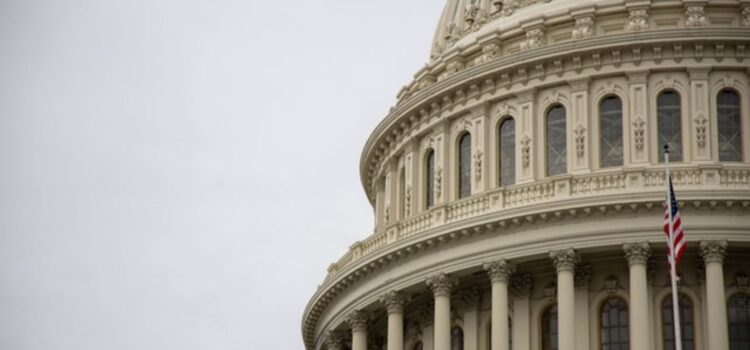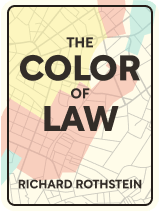

This article is an excerpt from the Shortform book guide to "The Color of Law" by Richard Rothstein. Shortform has the world's best summaries and analyses of books you should be reading.
Like this article? Sign up for a free trial here .
Are you looking for a review of The Color of Law? What’s the main argument of The Color of Law?
This review of The Color of Law explores the causes of racial residential segregation as identified in the book. The Color of Law argues that discriminatory government policy is primarily responsible for segregation in America.
Read the review of The Color of Law to better understand the role of the government in racial segregation.
Government Policy Created Racial Segregation
Widely reviewed and discussed when it was published in 2017, Richard Rothstein’s The Color of Law makes the case that racial residential segregation—the fact that African Americans largely live in discrete areas separate from white Americans—is the result of explicit government policy (“de jure” segregation) rather than personal preferences or random processes (“de facto” segregation). That is, historically, African Americans didn’t choose to live almost exclusively among themselves; rather, they were compelled to do so by an array of discriminatory policies designed and implemented by government at the federal, state, and local levels.
The distinction between de jure and de facto segregation is key. This is because segregation “by law” is unconstitutional and so remediable by legislation and litigation, whereas the Supreme Court has ruled that segregation “by personal choice” isn’t rectifiable under the Constitution.
Rothstein proves his claim that racial residential segregation was government-sponsored by examining the various means public officials used to promote segregation. Each chapter in the following review of The Color of Law focuses on one of these means, from the segregation of public housing to the exclusion of African Americans from federal home loans to the continual disadvantagement of African Americans in the labor market.
To emphasize the individual strategies government employed to segregate US localities, Shortform has had to omit some of the many examples Rothstein includes of racial residential segregation. (Those familiar with the book will also notice that we’ve redistributed the material that appears in the book’s first chapter and combined some shorter chapters.) As always, if you enjoyed our review of The Color of Law and are curious to know more, we encourage you to consult the author’s work itself.
The History of De Jure Segregation
As noted in the introduction, de jure segregation is unconstitutional: It infringes the Fifth, Thirteenth, and Fourteenth Amendments to the US Constitution. It was also outlawed by the 1866 Civil Rights Act, which prohibited any law that echoed the characteristics of slavery by disadvantaging African Americans.
Unfortunately, in 1883, the Supreme Court determined that housing discrimination didn’t represent a continuation of the “badges and incidents of slavery.” It wasn’t until 1968—when the Supreme Court overturned the 1883 decision and, separately, Congress passed the Fair Housing Act—that racial discrimination in housing was unambiguously prohibited.
Between 1883 and 1968, African Americans were systematically and repeatedly disadvantaged in the housing market due to government policy—specifically through the Federal Housing Administration and the Veterans Administration—with repercussions that extend into today.
For example, the primary source of wealth for American families is their home. Because Black Americans were unable to obtain financing, from either the government or private banks, to purchase homes in the middle of the last century, their descendants haven’t inherited the same wealth that white Americans have.
These descendants are also unable to file suit for remuneration on account of this historical discrimination. Because the Supreme Court ruled housing discrimination legal between 1883 and 1968, descendants of those discriminated against have no legal standing to sue.
Public Housing as a Segregating Agent
One of the most important methods by which government segregated cities was the construction of segregated public housing (“projects”) from World War I through to the 1960s and 1970s. By confining African Americans to subpar public housing in undesirable areas, federal, state, and local authorities promoted the (1) segregation of their cities and (2) the transformation of predominantly Black areas into slums.
Projects were segregated as a matter of policy. For example, they had to abide by the “neighborhood composition rule”—that is, they had to reflect the racial composition of the neighborhood around them.
During WWII, segregated projects were constructed near shipyards to house the influx of war workers. Black workers were housed close to worksites in shoddily constructed units, while white workers lived in sturdier projects further inland. (White workers were also subsidized to rent rooms from private landlords.)
After WWII, city-level public housing authorities used segregated public housing to ghettoize their African American residents. For example, in 1952, the NAACP took the San Francisco public housing authority to court, claiming that though the authority had promised to make all new construction integrated, it was trying to build a new segregated project. Under oath, the authority’s chairman admitted that the agency was purposely trying to confine African Americans to particular locations in the city.
Exclusionary Zoning Laws
Another key cause of racial residential segregation that will be explored in our review of The Color of Law was the enactment of discriminatory zoning laws. Zoning laws are local ordinances that limit how certain “zones”—or areas—in a municipality can be developed; racial zoning laws restricted African Americans from owning property in certain areas.
After the Supreme Court ruled racial zoning unconstitutional in Buchanan v. Warley, city authorities found workarounds and subterfuges that allowed them to continue segregating by race. Two such strategies were:
1) Economic Zoning
Officials passed ordinances limiting certain neighborhoods to single-family homes affordable only to middle-income people. Because African Americans had been historically and systematically discriminated against in the job market, many were lower-income and so could only afford housing in apartment buildings—structures that were banned by these ordinances. The result was that areas zoned for single-family homes stayed or became white while areas that allowed multiple-family dwellings stayed or became African American.
2) Industrial Zoning
Certain areas in municipalities are zoned specifically for industry to protect residents from nuisances like noise and air pollution. To further segregate their cities in the wake of Buchanan, city officials zoned areas near predominantly Black neighborhoods for industry. This move lowered property values in those areas, thereby reducing the current residents’ wealth and limiting their opportunities to move out.
An example of this method can be seen in South Central Los Angeles, a predominantly Black area. In the 1940s, the city began using “spot” rezoning ordinances to move automobile junkyards and commercial factories into the area, thus ghettoizing the residents.
How the New Deal Excluded Black Americans
However, Hoover’s efforts to promote homeownership were ultimately no match for the Depression, and when Franklin Delano Roosevelt took office, homeownership remained out of reach for most working- and middle-class families; even families who already owned their homes were having trouble making their mortgage payments.
Roosevelt responded to these challenges by creating two agencies, the Home Owners Loan Corporation (HOLC) and the Federal Housing Administration (FHA). As a rule, both agencies systematically discriminated against Black Americans.
The Home Owners Loan Corporation
Designed to keep current homeowners in their homes, the HOLC bought mortgages in danger of default and reissued them to the holder with more generous terms. For example, in the ’30s, most mortgages required 50% down payments, and borrowers could only pay off interest, not principle, until the mortgage came due after 5–7 years. The HOLC, however, offered borrowers 15-year terms and amortized payment plans (amortized payments include part of the principle as well as interest). This meant owners could gain equity in their homes even as they paid off their loans.
Although the HOLC’s mission was altruistic, it still expected its beneficiaries to make the payments to which they were obligated. So, to assess the risk of particular borrowers, the agency hired local real estate agents to appraise properties and neighborhoods. These real estate agents, bound by a segregationist code of ethics that assumed African American residents equaled lower property values and so higher risk of default, produced color-coded maps of metropolitan areas for the government to use as a guide for evaluating homes. The agents used red for neighborhoods with any African American residents—no matter how well off—and green for all-white neighborhoods, a practice that would come to be known as “redlining.” Residents in green neighborhoods had an easier time securing loans and thus were able to cement the monoracial—that is, white—makeup of those neighborhoods.
One representative example of redlining took place in St. Louis. In 1940, an appraiser colored Ladue, a suburb of the city, green, because no foreigners or African Americans lived there. Lincoln Terrace, a suburb with comparable housing stock and equally middle-class residents, was colored red—because it was predominantly African American.
The Federal Housing Administration
Although the HOLC did occasionally assist homeowners in redlined tracts, the redlined maps set a standard in the government—that certain neighborhoods were undesirable or problematic simply because they contained African Americans.
This standard was especially destructive when it came to the Federal Housing Administration (or “FHA”), whose mission was to increase homeownership by insuring new bank mortgages and facilitating more favorable terms (20% down; 20-year, amortized payment periods).
Like the HOLC, the FHA performed appraisals on the properties whose mortgages a bank wanted to insure. In 1935, the FHA issued its first manual to its appraisers; the manual explicitly referred to integration as leading to “instability” and a “reduction in values.” It also said that properties in neighborhoods that excluded “inharmonious” racial and ethnic groups should receive high ratings, thus increasing the likelihood homes in that neighborhood would be insured. The manual favored suburbs over urban areas, and it singled out integrated schools as a sign of lending risk. Subsequent editions of the manual, right up until 1952—i.e., throughout and after World War II—maintained similar guidelines.
The effects of this racialized policy were significant. For one, it prevented Black families from moving to the suburbs, where many white families were relocating. For example, in 1941, a real estate agent in New Jersey tried to sell twelve homes in a development called Fanwood to African American families. All the families had good credit, and local banks were willing to finance their purchase if the FHA would insure the mortgages. But the FHA declined, writing that no loans would be given to “colored developments.” Today, Fanwood’s African American population is about 5% while the county in which it’s located is 25% Black.
The Role of Localities
As much as federal policy contributed to racial residential segregation, the small-scale efforts by state and municipal governments to keep their communities segregated, when considered in their totality, clearly point to a system of de jure segregation in the United States.
Some of the municipal discriminatory policies we identified during our review of The Color of Law are:
Slum Clearance
White community groups and public officials weren’t only concerned with excluding African Americans from residential areas—they also made concerted efforts to remove them from urban downtowns and business districts. (These were the areas into which Blacks had been pushed due to discrimination in the suburbs.) To reserve these economically important areas for whites, officials practiced “slum clearance”: the condemnation and demolition of dilapidated structures and the forced relocation of their current residents.
The most common impetus for slum clearance was infrastructure projects, in particular the federal interstate highway system. For example, in 1956, the Florida State Road Department routed a section of I-95 through a Black enclave adjacent to Miami’s downtown. By the time of the highway’s completion in the 1960s, the area’s African-Ameircan population of 40,000 had been reduced to 8,000.
School Placement
Prior to Brown v. Board of Ed., the famous 1954 Supreme Court case ending the doctrine of “separate but equal” in US public schools, many states used the location of segregated public schools to practice racial residential segregation.
One prominent example concerns Austin, TX. In its 1928 “Master Plan,” the city evaded a Supreme Court ruling that housing segregation on the basis of race was unconstitutional by placing a variety of Black-only services, including public schools, on the city’s Eastside. The effect was significant: In 1930, the African American population of the integrated Wheatsville neighborhood was 16%; by 1950, after the segregated school for African Americans was shuttered, it was 1%.
State-Sanctioned Violence
In general, government can’t be held responsible for the intimidation tactics used by white supremacists to defend segregation. However, when public authorities either turn a blind eye—or, worse, encourage that intimidation—it amounts to an unconstitutional infringement of African Americans’ rights and de jure segregation.
Some of the earliest instances of state-sanctioned abuse of African Americans for the purposes of segregation occurred in Chicago. In the early 1900s, white gangs would throw rocks through the windows of African Americans to coerce them into moving. In the early 20s, whites firebombed African American homes on the border between white and Black areas. Despite two deaths from these firebombings, Chicago law enforcement neither made arrests nor pursued prosecutions.
This sort of vandalism persists into living memory. In 1985, an African American couple who’d moved into Sylvania, a suburb of Louisville, had their house firebombed twice.

———End of Preview———
Like what you just read? Read the rest of the world's best book summary and analysis of Richard Rothstein's "The Color of Law" at Shortform .
Here's what you'll find in our full The Color of Law summary :
- How racial residential segregation is the result of explicit government policy
- The three reasons why racial segregation is so difficult to reverse
- The steps that could lead to a more integrated and equitable society






